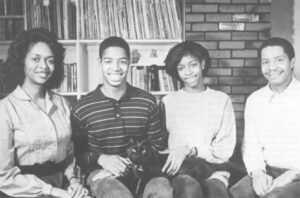Brenda Lane
- 1986

Fellowship Title:
- America's New Black Middle Class
Fellowship Year:
- 1986

Black Professionals in the South
KNOXVILLE, Tenn.-It was a long way from the old neighborhood in mostly black south-side Chicago. On a recent Saturday afternoon in a Knoxville suburb, Edye Ellis glanced up from her kitchen table, paused between bites of a turkey sandwich and watched as a neighbor’s cow ran across her wide freshly cropped lawn. Ellis’ two gardeners, a white man and woman, shouted in accents reminiscent of guitar twangs, and gave chase. Edye Ellis, director of publicity at the University of Tennessee. Ellis excused herself, walked past the hand-carved African masks decorating her living room walls, and coolly viewed the scene from her porch. “As a black professional,” Ellis said later, “you have to be willing to be very adventurous.” Ellis, 42, the director of publicity at the University of Tennessee, lives in Norris, where other black faces are scarce. There are other differences, also. The white neighbors, to the right of her split rail wooden fence, are farmers. Those across the road run the Museum of Appalachia, a storehouse of hillbilly memorabilia. But these differences are

Children of the Black Middle Class
On a Saturday morning late in December, hundreds of black parents, including many professionals, and their children, attended a cultural event at the American Museum of Natural History in Manhattan. The occasion was a Kwanzaa festival, an African-American holiday that celebrates the richness of black culture with the lighting of candles, poetry and feasting. To the beat of a Stevie Wonder tune, three brown face puppets performed a skit depicting a black teenager arrested on suspicion of robbery after innocently walking through a white neighborhood. Eventually, he was sentenced to prison. In the back row of the auditorium, an adolescent giggled. His mother, dressed in a costly Burberry raincoat, glared at him. “Better not laugh,” she said. “That could happen to you.” Her message was understood by many nearby. It carried a warning often repeated by black parents, cautioning that success cannot insulate one from the complications of being black. The youth fell silent and looked perplexed. Ironically, when he and his mother departed, home was in a predominately white neighborhood, if they were like

The Price of Success
On a typical weekday morning, black women are blazing new trails across America. In the nation’s capital, Karen Howze, 35, a managing editor for USA Today – circulation 1.4 million – joined the paper’s other editors for a daily story conference. Karen Howze, 35, a managing editor for USA Today. At the U.S. Senate, Deputy Sergeant-At-Arms Trudi Morrison, 36, prepared for a working lunch with Senator Robert J. Dole. As second in command for administrative and protocol needs, she oversees 2,200 employees and a $ 100 million budget. In New York, Mary Ann Spraggins, 38, vice president for Salomon Brothers, the big investment banking firm, received a call from the director of the state agency her company has been wooing. Spraggins’ bid for a $200million municipal bond deal has been approved. In Lawrence, at the University of Kansas, vice-chancellor Marilyn Yarbrough, 40, turned to draw a chalk diagram during a law seminar outlining the details of a runoff primary. Young, gifted and black, they seem to have it all. But except for Morrison, their personal

The Dilemma of The Black Middle Class
SAN FRANCISCO–The reminders and discomforts linger painfully close to the surface and can be aroused by something as seemingly simple as a case of mistaken identity. On a weekday morning last spring, a white attorney was ushered into Federal Judge Thelton Henderson’s decorous chambers and was greeted by a black man in a dark suit. On a nearby coat rack a judge’s robes hung still and lifeless. Both men took their seats, and a dialogue ensued concerning the case the counselor had traveled from a nearby county to discuss. Soon the attorney checked his watch. A few minutes later, he began drumming his fingers on the polished walnut conference table. The black man continued to talk, ignoring the visitor’s impatience. Seconds went by in single file; more talk and increasing agitation. Finally, the attorney asked, “Where is Judge Henderson?” For a moment, a look of confusion crossed the black man’s brow and then he realized the attorney’s error. “He assumed that because I was black I was not the judge,” Henderson later explained. Federal Judge
